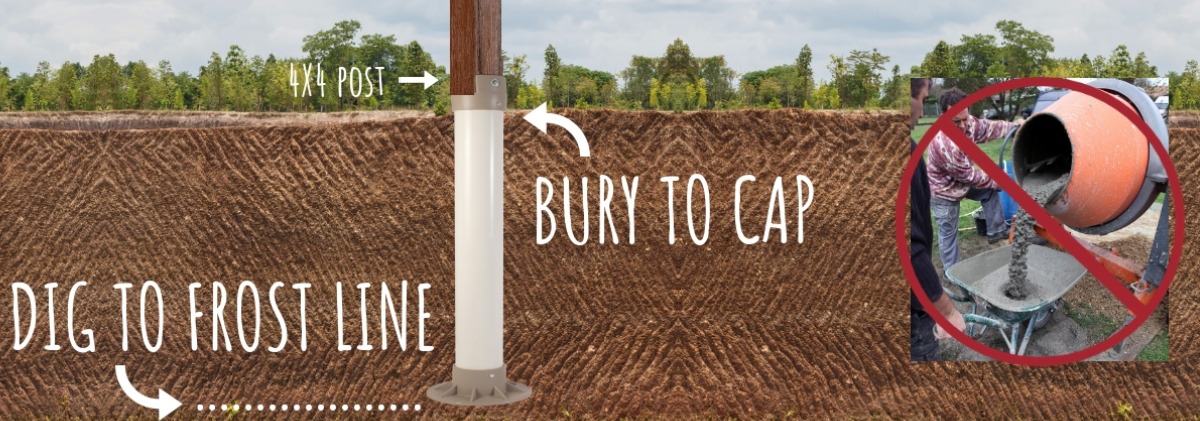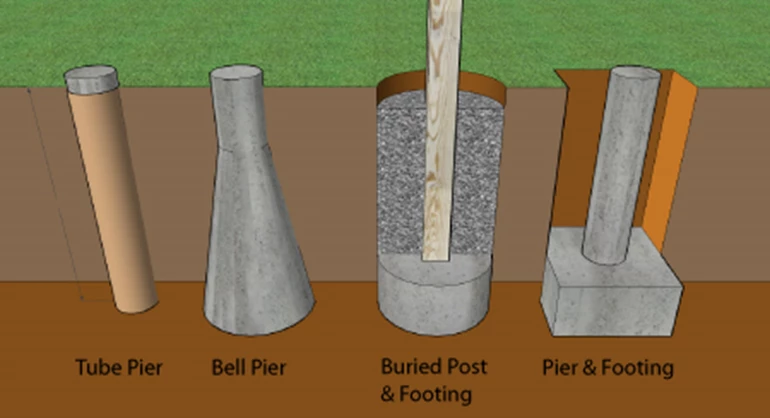Picking the Right Deck Footings for Stability and Toughness
The durability and safety and security of your deck depend heavily on the type of grounds you pick, as they supply the essential support and security to hold up against the test of time. In this discussion, we will discover the various types of deck grounds, consider the crucial factors to evaluate when making a decision, and dig right into the pros and cons of different choices.
Kinds of Deck Footings
These grounds are composed of a cylindrical hole filled up with concrete, which offers a solid foundation for the deck messages. Concrete pier footings are fairly simple to set up and provide outstanding stability, making them a prominent selection for several deck tasks.
These footings are installed by screwing them right into the ground, which creates a safe foundation for the deck. They additionally enable for easy change and progressing of the deck if needed.
Alternatively, some builders choose precast concrete footings. These grounds are made from long lasting concrete and come in numerous sizes and shapes to fit different deck layouts. Precast concrete footings are convenient to set up and provide a secure base for the deck structure.
Finally, an additional option is the post-in-anchor ground system. This kind of ground involves driving a metal anchor right into the ground and attaching it to the deck blog post. It provides flexibility in regards to positioning the deck blog posts and is suitable for decks with light-weight structures.
When selecting the best sort of deck footing, it is important to think about variables such as soil problems, deck load, and regional building regulations (Deck Footings). Consulting with a professional specialist or architectural designer can aid ensure the proper ground is chosen for a stable and risk-free deck
Variables to Consider When Selecting Grounds
When selecting the proper grounds for a deck, it is essential to very carefully take into consideration different variables such as soil conditions, deck tons, and adherence to regional building ordinance. These elements play a substantial duty in ensuring the stability and longevity of the deck framework.
The kind of dirt on which the deck will be built identifies the type of footings required. On the various other hand, decks constructed on clay or extensive soils may need footings that can suit the dirt's tendency to expand and agreement.
An additional crucial aspect is the deck tons. The weight of the deck, including the products utilized and any type of potential real-time tons such as furniture or celebrations, should be thought about when choosing footings. The grounds should be designed to birth the weight of the deck and distribute it uniformly to protect against any kind of architectural concerns or failings.
Finally, adherence to local building ordinance is critical. Structure codes vary from area to region, and it is important to abide with the particular requirements established by the local authorities. Deck Footings. These codes make certain that the deck is developed securely and meets the essential requirements for structural stability and load-bearing ability
Concrete Footings: Advantages And Disadvantages

When made use of as the foundation for a deck,Concrete footings provide numerous benefits and drawbacks. On the silver lining, concrete grounds provide outstanding security and durability. Concrete is a strong and stiff product that can sustain hefty loads and stand up to numerous climate problems. It also has a long life expectancy, making it a trusted choice for long-term use.
An additional benefit of concrete grounds is their versatility. They can be put right into various shapes and sizes to suit various deck designs and setups. Concrete footings can be personalized to fit the details needs and requirements of the deck framework.
Nonetheless, there are likewise some downsides to utilizing concrete grounds. One major downside is the expense and labor entailed in their installment. Concrete grounds require excavation and typically require the aid of hefty machinery. This can increase the total expense of the deck project and may call for expert support.

Helical Piers Vs. Sonotubes: Which Is Better?
In thinking about the structure alternatives for a deck, the contrast between helical piers and sonotubes is vital in establishing the superior choice. Helical piers, also known as screw piles, are steel shafts with helical plates attached to them. They are look at here twisted into the ground making use of hydraulic equipment, giving a secure and sturdy structure for the deck. On the various other hand, sonotubes are round types made from cardboard or fiber material that are filled up with concrete. They are put in an opening dug right into the ground and give assistance for the deck.
When it involves security and longevity, helical piers have the top hand. The helical plates on the piers produce a strong hold with the dirt, preventing any movement or moving of the deck. This is specifically valuable in areas with unstable or moving soil problems. Sonotubes, on the other hand, rely only on the concrete filling up for stability, which might not provide the same degree of stamina and resistance.
In regards to installation, helical piers are reasonably easier and faster to mount compared to sonotubes. The hydraulic equipment used to turn the piers into the ground makes certain a effective and quick process. Sonotubes, on the various other hand, call for digging openings and putting concrete, which can be lengthy and labor-intensive.
Furthermore, helical piers are an even more versatile choice. If needed, they can be made use of in different soil problems and can be adjusted or enhanced. Sonotubes, on the various other hand, may require extra support, such as rebar, in certain dirt conditions or locations with high lots requirements.
Choosing the Right Footings for Your Deck's Dimensions
For optimal architectural honesty, it is important to carefully choose the proper grounds that straighten with the measurements of your deck. The measurements of your deck, including its size, size, and elevation, play a significant role in identifying the type and size of footings called for.
When picking grounds for your deck, it is essential to consider the load-bearing capacity of the soil. The weight of the deck, combined with the weight of any furniture or individuals on it, exerts a significant force on the footings (Deck Footings). It is critical to select footings that can properly support this weight without sinking or changing over time.
The size and shape of the footings should additionally be thought about. Larger decks with greater dimensions call for bigger footings to give enough stability and support. The form of the footings, whether they are square or rounded, depends upon the design and format of the deck. Furthermore, the depth at which the grounds are set up ought to be identified based upon the frost line in your area to protect against any heaving or changing because of freezing temperatures.
Conclusion
In conclusion, picking the appropriate deck grounds is critical for ensuring security and longevity. Variables such as the kind of grounds, the deck's measurements, and the pros and disadvantages of different choices visit homepage must be thought about.
These grounds are composed of a cylindrical hole filled with concrete, which provides a strong foundation for the deck blog posts. Concrete pier footings look at here now are fairly very easy to install and use exceptional security, making them a popular selection for numerous deck jobs.
Precast concrete footings are practical to set up and supply a steady base for the deck framework.
It uses versatility in terms of placing the deck articles and is appropriate for decks with lightweight structures.
Concrete grounds supply a number of benefits and disadvantages when used as the structure for a deck.
Comments on “Deck Footings Revealed: Comprehending the Secret Parts of a Trusted Deck Framework”